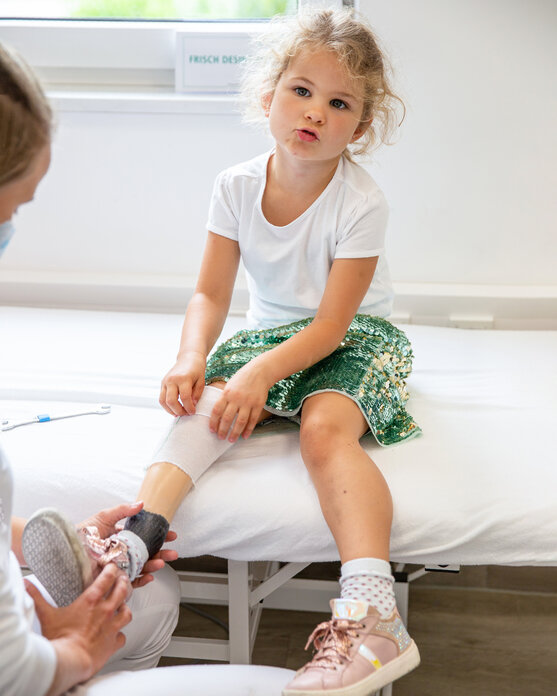An orthoprosthesis compensates for the length deficit of the malformed leg and, if necessary, provides corrective support.
We train you in the everyday use of your orthoprosthesis.
Make an appointment over the phone or send us a message!

Orthoprosthesis
Dysmelia? You can walk with this aid!
An orthoprosthesis is an orthopedic aid that has both orthotic and prosthetic design features. It compensates for the length deficit of the deformed leg (prosthesis portion) and, if necessary, supports it correctively (orthosis portion).
Orthoprostheses have a foot prosthesis and, if necessary, a prosthetic knee joint. The main difference between prostheses and orthoprostheses is that an orthoprosthesis is intended to hold a limb instead of a stump. This limb can be severely decimated in length and volume. In addition, functional units such as knee joints or ankle joints are often not regularly positioned. However, there are almost always toe, foot, lower leg and/or thigh sections on the deformed limb.

Let yourself be inspired! We follow many interesting patients during their Pohlig appointment and give you personal insights.

For those who want to delve even deeper into the subject, we have a suitable video for almost every area of treatment!

Take a look behind the scenes at Pohlig and learn about different health conditions and our innovative assistive technology solutions!

Sometimes funny, sometimes explanatory, sometimes emotional - but above all always entertaining: our videos on TikTok!
Who needs an orthoprosthesis?
If your legs are malformed, an orthoprosthesis can allow you to walk and stand.
Congenital deformities or dysmelia are various types of deformities in the hands, arms, or legs. Depending on the severity, they can lead to cosmetic and functional impairments of the limbs...
Standing in life on both legs
Objectives of orthoprosthesis treatment
The treatment of patients with congenital deformities in the lower limbs is very complex overall and technically very demanding. We achieve the best result for you by coordinating your care with the treating physician and our physiotherapists.
Objectives of orthoprosthesis treatment:
- Achieving, maintaining or improving standing and walking ability
- Stabilization in the best possible functional and axis-appropriate position
- Improvement of joint mobility
- Maintenance and promotion of range of movement
- Avoidance of emerging malpositions
- Restoration of body image
- Promotion of participation in everyday life

Tibial aplasia and subsequent amputation
First orthosis, then prosthesis
Moritz was born with unilateral tibial aplasia, which means he is missing his shin bone on one leg. So he was treated with orthoprostheses until the age of seven. In order to enable Moritz to wear a normal prosthesis, the left lower leg had to be amputated. Thanks to his knee disarticulation prosthesis, sports enthusiast Moritz now has completely new possibilities...


